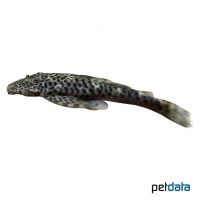Red Fin Thresher Pleco (Squaliforma emarginata)
| Red Fin Thresher Pleco Squaliforma emarginata | |
|---|---|
| Name | Red Fin Thresher Pleco |
| Name Lat. | Squaliforma emarginata |
| Synonym | Aphanotorulus emarginatus, L11, L108 |
| Family | Suckermouth Armoured Catfishes |
| Family lat. | Loricariidae |
| Order | Catfishes |
| Order lat. | Siluriformes |
| Origin | Brazil, Ecuador |
| Habitat | Rivers, streams |
| Diet | Omnivore, soft wood |
| pH | 6.0-7.0 |
| Behavior | Nocturnal, peaceful |
| Keeping | Individual, group |
| Care Level | Moderate |
| Reproduction | Cave spawner |
| Breeding | None reported |
| Life Span | 8-12 years |
| Protection | No |
| Metric Units | |
| Size | 40 cm |
| Temperature | 25-28 °C |
| Hardness | 5-10 °dH |
| Aquarium | ~ 500 l |
| US Units | |
| Size | 16" |
| Temperature | 77-82 °F |
| Hardness | 89-178 ppm |
| Aquarium | ~ 130 gal |
Distribution and habitat
The delta-tailed catfish originate from the catchment areas of the Rio Xingu and Rio Trombetas in Brazil and the Rio Napo in Ecuador. They live in oxygen-rich rivers and streams with sandy bottoms and stones.
Maintenance
The aquarium should have robust planting, with roots and branches that provide hiding places and are also part of their diet, as well as caves and a sandy substrate. Subdued light and a weak current is ideal.
No ammonia, ammonium and nitrite should be detectable, and the nitrate value should not exceed 100 mg/l. To ensure the water quality and oxygen content, a filter and heater adapted to the aquarium size is required, as well as lighting for the species-appropriate day-night rhythm of the animals.
Diet
They feed on plant and animal food. For a balanced diet, feed once a day with a high-quality dry food for loricariid catfish (granules, pellets, chips, tablets), supplemented with algae leaves, soft wood and fresh vegetables, such as zucchini, broccoli, bruised peas, scalded spinach, as well as zoopankton, cyclops, daphnia, artemia, mosquito larvae, etc. (live or frozen)
Feed only as much as will be eaten within a few minutes, excluding plant foods. Regular and varied feeding promotes health and increases resistance.
Behaviour and compatibility
They are crepuscular and nocturnal. Older animals sometimes behave intra-species territorial, without serious confrontations. Multiple animals should only be kept in large and richly structured tanks. They are very peaceful towards other fish and can be socialized well with larger fish.
Basically, only compatible fish species with similar demands on water quality and water temperature should be socialized
Sex dimorphism
There are no known external distinguishing characteristics.
Reproduction and breeding
There are no known reports of successful breeding in the aquarium. It is assumed that they are cave breeders.
Important
In its large distribution area, several site variants are known, which were listed under different L-numbers. Thus, the L11 originates from the Rio Xingu and the L116 from the Rio Trombetas in Brazil, and the L108 from the Rio Napo in Ecuador.
When catching, fine-meshed nets should be used as much as possible so that the hard rays of the pectoral fins or the skin teeth (odontodes) do not get caught on the bone plates, which can cause painful puncture wounds when touched.
The well-being of the fish should be checked regularly. Temperature should be checked daily, pH, hardness and nitrate levels at least every 14 days. Regular partial water changes are recommended, even when contaminant levels have not yet reached the upper limit. Sudden changes in water quality should be avoided. Newly introduced fish must be accustomed slowly to the water in the aquarium
Further literature can be found in your pet store.
References
Text: Werner Winter; Image: petdata
Source: BMEL (1998): Tierschutzgutachten - Haltung von Zierfischen (Süßwasser); ENGELMANN (2005): Zootierhaltung - Tiere in menschlicher Obhut: Fische, Verlag Harri Deutsch; EVERS & SEIDL (2005): Wels Atlas 2, Mergus Verlag
- Gemäß § 21 Abs. 5 Tierschutzgesetz idgF
